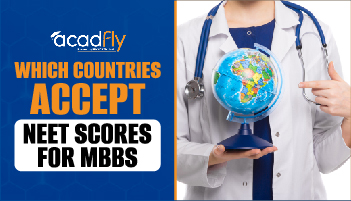
USMLE Syllabus: The United States Medical Licensing Examination (USMLE) is a multi-step assessment that evaluates a candidate’s ability to apply medical knowledge and principles necessary for the safe and effective practice of medicine. Administered by the Federation of State Medical Boards (FSMB) and the National Board of Medical Examiners (NBME), the USMLE is a mandatory requirement for medical licensure in the United States. Provided here is an in-depth look at the USMLE, including a breakdown of its USMLE syllabus, structure of each step, eligibility criteria, and key exam insights for candidates preparing to enter clinical practice or postgraduate training in the U.S.
Understanding USMLE Syllabus and Structure
The USMLE is composed of three steps that collectively evaluate the scientific foundation, clinical acumen, and practical decision-making skills required in the U.S. healthcare environment. Each step focuses on specific competencies and is designed to mirror the progressive responsibility a physician assumes in real-world clinical settings.
|
Understanding USMLE Structure |
||
|
USMLE Step |
Primary Focus |
Exam Format |
|
Step 1 |
Basic science integration and foundational knowledge |
Multiple-choice questions; 280 questions across 7 one-hour blocks |
|
Step 2 CK |
Clinical knowledge and patient-centered care |
Multiple-choice questions; 318 questions across 8 one-hour blocks |
|
Step 3 |
Clinical management and autonomous decision-making |
Two-day exam; includes MCQs and computer-based case simulations (CCS) |
Step 1: Foundations of Basic Sciences
Step 1 forms the base of the licensing pathway by evaluating the examinee’s understanding of the core biomedical sciences. This foundational knowledge is critical as it enables physicians to approach clinical problems systematically and scientifically, applying concepts in physiology, biochemistry, and pathology to real clinical scenarios.
Syllabus Components:
-
Anatomy – Structural organization of the human body, neuroanatomy
-
Physiology – Organ system functions and homeostasis
-
Biochemistry & Molecular Biology – Enzymes, metabolism, genetic principles
-
Pathology – Mechanisms of disease, cellular injury, systemic pathology
-
Microbiology & Immunology – Infectious agents and host defense
-
Pharmacology – Mechanisms of drug action, interactions, adverse effects
-
Behavioral Sciences – Psychological principles, ethics, health care delivery
-
Integrated Topics – Nutrition, epidemiology, aging, genetics
Note: Step 1 is currently scored as Pass/Fail, with the emphasis shifting to holistic evaluation and performance in later steps.
Step 2 CK: Clinical Knowledge
Step 2 CK evaluates the candidate’s ability to apply clinical knowledge in real-life scenarios. The exam emphasizes diagnosis, disease progression, and management across multiple organ systems and patient demographics, reflecting the expectations of physicians in supervised clinical environments such as hospitals and clinics.
|
Clinical Knowledge |
|
|
Clinical Disciplines |
Organ/System Modules |
|
Internal Medicine |
Cardiovascular, Respiratory, Renal |
|
General Surgery |
Gastrointestinal, Musculoskeletal |
|
Pediatrics |
Growth, development, congenital diseases |
|
Psychiatry |
Mental health, mood disorders |
|
Obstetrics & Gynecology |
Reproduction, prenatal care |
|
Public Health & Preventive Medicine |
Epidemiology, patient safety |
Step 3: Final Licensure Evaluation
Step 3 is the final assessment in the USMLE sequence, designed to test the candidate’s ability to provide unsupervised medical care. It is intended for those who have completed their medical degree and earlier steps, and it serves as a prerequisite for obtaining a full, unrestricted license to practice medicine in the United States.
Structure and Focus Areas:
-
Day 1: Foundations of Independent Practice (FIP)
Emphasizes medical knowledge, epidemiology, biostatistics, and application of foundational science to patient care. -
Day 2: Advanced Clinical Medicine (ACM)
Assesses ability to diagnose and manage patients over time, particularly in outpatient settings. Includes 13 computer-based case simulations (CCS) that test data collection, management, and outcome prediction.
Decoding USMLE Eligibility Criteria
Understanding eligibility requirements is vital before registering for the USMLE. The process is inclusive of both U.S. and international medical graduates, but the criteria vary depending on the exam stage and institutional affiliations.
Who Can Apply:
-
Step 1 and Step 2 CK:
Medical students officially enrolled in or graduates of a medical school listed in the World Directory of Medical Schools, with a sponsor note indicating ECFMG eligibility. -
Step 3: Applicants must have obtained an MD or equivalent degree, passed both Step 1 and Step 2 CK, and be certified by the Educational Commission for Foreign Medical Graduates (ECFMG) if applicable.
Decoding USMLE Exam Duration and Scheduling
Proper planning is required to manage the lengthy exam sessions across all USMLE steps. The structure allows scheduled breaks, but time management is critical to ensure optimal performance across all sections.
|
USMLE Exam Duration and Scheduling |
||
|
Exam Component |
Total Duration |
Scheduled Breaks |
|
Step 1 |
8 hours |
45 minutes (can be extended) |
|
Step 2 CK |
9 hours |
45 minutes (can be extended) |
|
Step 3 – Day 1 |
7 hours |
45 minutes |
|
Step 3 – Day 2 |
9 hours |
45 minutes |
Decoding USMLE Scoring and Evaluation
Each USMLE step employs a distinct scoring methodology designed to assess different competencies. Understanding how scores are calculated and reported helps candidates interpret their performance and guide future preparation efforts.
Current Scoring Overview:
-
Step 1: Pass/Fail only
-
Step 2 CK: Numeric score (range typically 1–300) with a minimum passing score established by the USMLE program
-
Step 3: Numeric score and Pass/Fail status
Decoding USMLE Preparation Considerations
USMLE preparation demands strategic planning, long-term discipline, and consistent revision. Study materials vary in format and depth, and choosing resources that align with one’s academic background and clinical exposure is essential for comprehensive preparation.
Preparation Methods Include:
-
Official NBME/USMLE sample questions and practice assessments
-
Medical reference books and Qbanks
-
Online video lectures and topic-wise reviews
-
Flashcards, study notes, and spaced repetition tools
-
Clinical case practice and simulation software
USMLE for International Medical Graduates (IMGs)
For international candidates, the USMLE is more than an exam, it is a gateway to medical practice in the U.S. IMGs must fulfill specific regulatory requirements and secure ECFMG certification to participate in U.S. residency programs and obtain a state license.
Key Requirements for IMGs:
-
Graduation from a recognized foreign medical school listed in the World Directory
-
Passing Step 1 and Step 2 CK
-
Verification of medical credentials
-
Application for ECFMG certification
-
Obtaining a USMLE/ECFMG Identification Number
Delving Into Key Exam Insights of USMLE
Thorough preparation is enhanced by understanding how the USMLE is structured not just in content but also in approach. The exam is designed to reflect real clinical scenarios, testing not only what candidates know, but how they think and respond under time constraints.
Core Insights:
-
Each question is case-based, requiring synthesis of data rather than rote recall.
-
Effective time management during the exam is as important as content knowledge.
-
Repeated practice with clinical vignettes improves decision-making under pressure.
-
Simulation of testing conditions can improve focus and reduce anxiety.
Recent Changes and Trends in USMLE
In recent years, the USMLE has undergone several policy and format updates aimed at enhancing the fairness and utility of the assessment process. Staying updated with these changes ensures candidates prepare based on the latest standards.
Key Changes:
-
Step 1 converted to Pass/Fail in 2022 to reduce reliance on scores in residency selection.
-
Discontinuation of Step 2 CS: Communication skills are now evaluated through other standardized methods.
-
Greater emphasis on clinical reasoning and decision-making in Step 3.
-
Increased availability of online practice tools and assessment modules for remote learners.
USMLE Syllabus FAQs
What subjects are covered in the USMLE Step 1 syllabus?
Does the USMLE Step 2 CK syllabus focus on clinical or basic sciences?
What topics are emphasized in the USMLE Step 3 syllabus?
Are behavioral sciences included in the USMLE syllabus?









